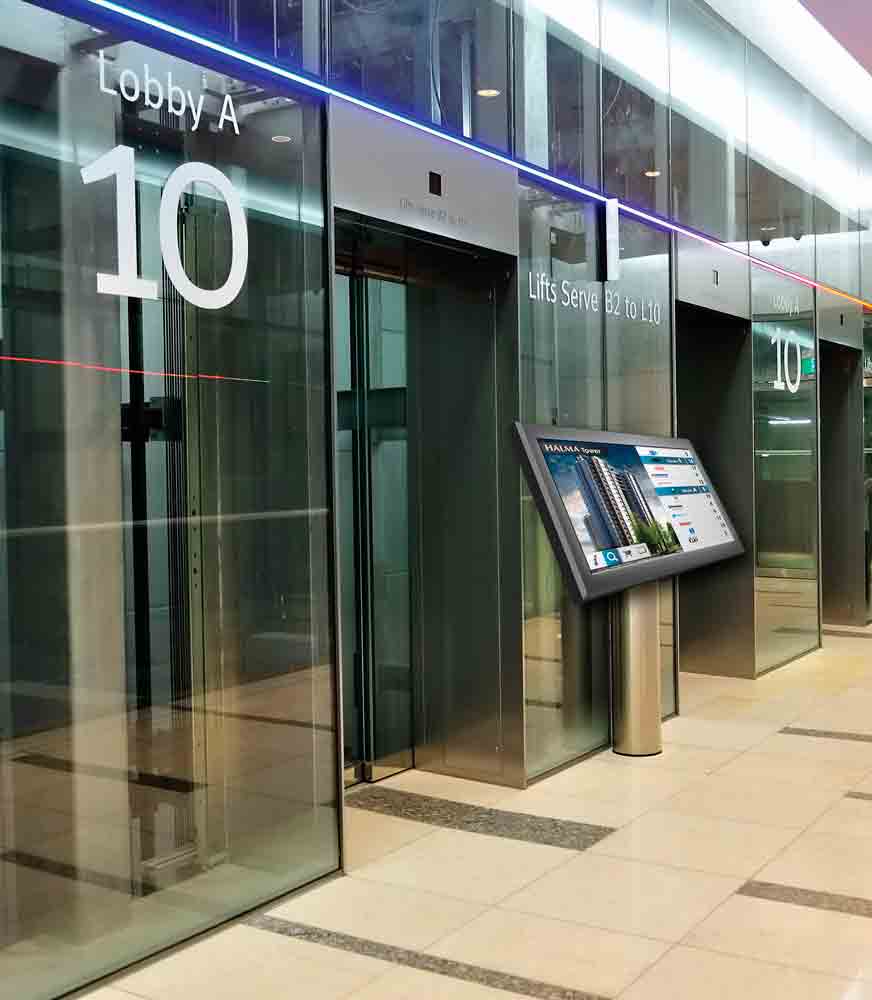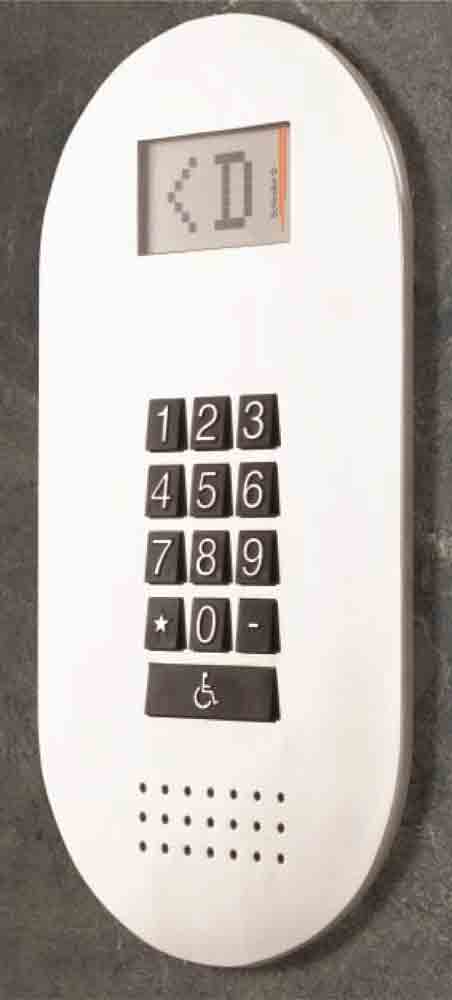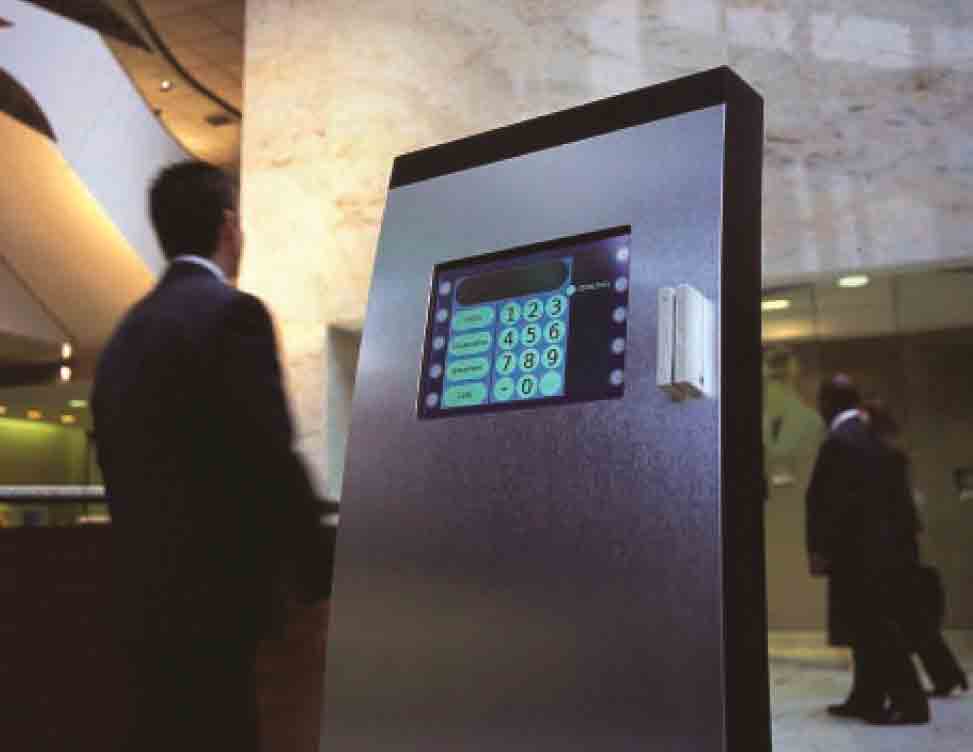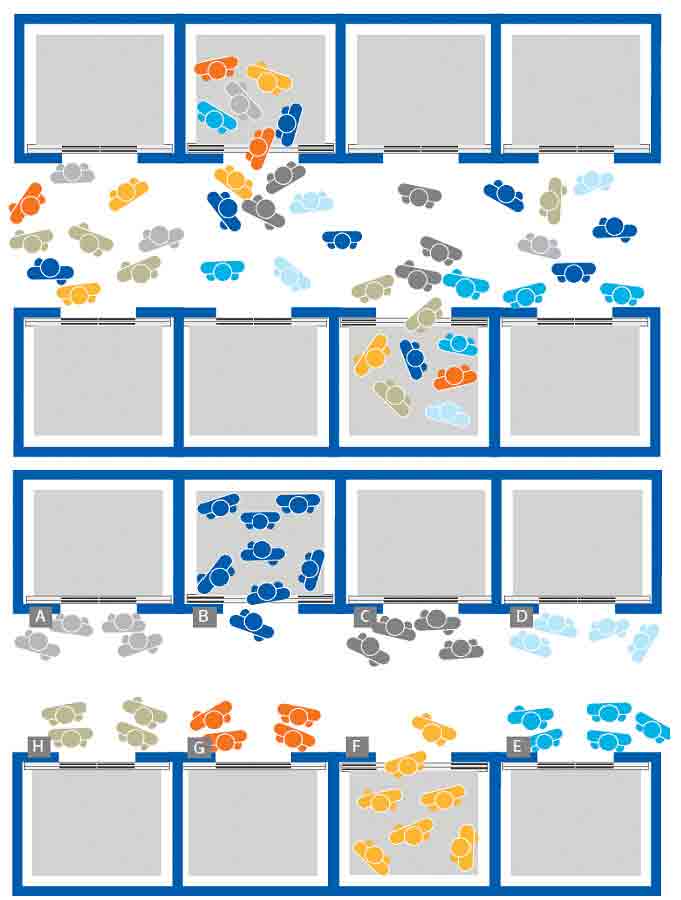An explanation of how these systems are used, including advantages and disadvantages
by Chris Woodman and Dinesh Musalekar
With more than eight million elevators in service around the world, elevator use is an essential part of urban life, and, with strong projected growth of construction during the next 15 years, this should only intensify. The increasing level of complexity and magnitude of high-profile construction projects in the world mean there is also an increased need to effectively and efficiently manage the more than one billion elevator rides taken per day.
Destination-dispatch systems (DDS), also known as destination-control systems, are becoming prevalent, particularly in high rises. These systems replace traditional two-button call and acknowledgement systems with a terminal in which passengers enter their destination, and the system provides instructions for which elevator to take. This idea is not new and was patented in 1961[1] by Australian engineer L.W. Port. Port’s concept was ahead of its time, as the required dispatching algorithms could not be computed or implemented economically because microprocessors were unavailable and control was through relay logic. With the advent of affordable microprocessors in the 1980s, Schindler introduced the first version of this dispatch system, known as Miconic 10.[2]
Using DDS
Typical System/User Interaction
When entering a building, the user may or may not know which floor to travel to, with most consulting a floor directory or an information booth to determine their destination. Once this information is obtained, they then proceed to the elevators and press an up or down call button. They would then wait for an elevator to arrive, step inside and select the floor they desire by pressing a traditional mechanical button. The elevator proceeds to that floor, stopping along the way to let passengers off or on. During this journey, there are two points to note: wait time (time from when the passenger presses the call button to the car’s arrival) and transit time (time taken for the passenger to reach the selected destination).
Typical DDS/User Interaction
Upon entering the building, the user may need to determine to which floor to travel. Having made the choice, the user proceeds to a terminal-input device, typically a mechanical keypad (Figure 1)[3] or touch-enabled display (Figure 2).[4]
At this point, the passenger inputs the desired floor, and the display informs the passenger which elevator will take him or her to their destination. Each elevator has an identification marking, so passengers know which elevator is which (e.g, in Figure 1, elevator “D” has been assigned, and the corresponding elevator will be marked “D”). The passenger proceeds to that elevator, waits and enters upon arrival. There are no buttons inside the elevator, as the destination has been preassigned, and the system knows to which floor to travel. This also means passengers cannot select or change their destination once inside the car. The elevator proceeds to the assigned floor, at which point the passengers exit.
Note that where accessibility codes such as the Americans with Disabilities Act (ADA)[5] apply in the U.S., the system may have a key designated with the international disability symbol, a wheelchair. Different systems activate different features, such as voice confirmation and instructions at the terminal in the form of audio/visual indicators at the elevators serving the passengers’ destination and ensuring longer wait times for the specific elevator, allowing passengers time to board, when this button is pressed. This description defines what is known as a full destination-based dispatch system, which eliminates the use of the in-car operating panel, with the exception of emergency communication devices and firefighter buttons. Typically with these systems, a terminal input device is also present on each floor or landing. There are also partial DDSes that would have a main floor or lobby terminal input device with traditional up/down buttons at landings. The cars could also include a car-operating panel, which would accept car calls after servicing the main floor calls.
Why Do I Need a DDS?
In summary, the main reasons for DDSes are: to improve building traffic flow, increasing capacity of the elevator installation; reduce average wait times; and decrease average time to destination. It has been said that buildings can be served by fewer elevators than needed in a conventional installation. This has been the subject of much debate between various elevator manufacturers and consultants. Traditional performance and efficiency claims[6] have been ongoing since the first installations of this technology until the present day and have become one of the points of difference claimed by various manufacturers. For more detailed information, of note are two articles related to traffic performance of DDSes utilizing conventional traffic analysis software[7] and comparisons of handling capacity between conventional and destination-dispatch systems.[8]
With an increasing focus on energy consumption and “green” buildings, there are also claims that the increased efficiency of these systems leads to reduced energy consumption. This could also allow more floors to be served with potentially fewer hoistways, with building owners gaining potential floor space.[9] While there are advantages and disadvantages to the technology, certain building types are better suited for the system. These tend to be primarily related to average time to destination and number of floors and elevators required.[10]
Advantages
- DDSes group passengers in the main lobby by destination, reducing the number of stops an elevator makes during peak times. This is best illustrated in Figure 3, which shows a lobby for a conventional controller and the impact of pre-allocation of passengers to specific elevators in a destination-dispatch system.
- By assigning elevators using DDS, one can see how the number of stops each elevator will make are minimized, decreasing time to destination. This reduction in the number of stops increases handling capacity.
- These systems reduce average times to destination, hence reduced passenger frustration and increased service levels to the higher floors of a building.
- Potential energy savings and increased floor area for building owners
Disadvantages
- For passengers traveling during non up-peak or down-peak times, there may be no perceived decrease in time to destination.
- There may be an increase in wait time at main lobbies while waiting for an assigned elevator, as opposed to entering the first available. This is compensated by a reduced number of stops and decreased overall time to destination.
- DDSes assign elevators to specific floors. Once assigned, these floors are fixed, creating a loss of flexibility to react to new requests for service.
Additional Features
It should be noted that extra security and usability features can be integrated into DDSes. Options include identification cards allowing users to simply swipe or place their card in proximity to a reader. The card may carry some personal information and limit passengers to specific floors in a building. One of the latest offerings from Schindler is its Personal Occupant Requirement Terminal (PORT)[11] system. This system claims to direct people through complete buildings in the shortest possible route.
Building Types
It has been argued that DDSes are more applicable to certain types of buildings. Though the technology has been deployed for many years, it still only makes up a small percentage of global installations. Thus, when people unaware of the technology enter a building utilizing DDS, there is potential for confusion. However, the learning curve is steep, which has led some consultants and building planners to argue that the systems are best deployed in buildings where the number of new entrants is limited – for example, in office or residential buildings not frequented by the general public.
Available DDS Systems
DDSes are available from many elevator suppliers, including:
- Schindler (Miconic 10/ID)[12]
- Schindler (PORT)[11]
- ThyssenKrupp Elevator[13]
- Otis (Compass)[14]
- Computerized Elevator Control Corp.[15]
- KONE (Polaris)[16]
- Kollmorgen (LiftXpress)[17]
- Fujitec (Viridian)[18]
- Motion Control Engineering[19]
TL Jones Passenger Management Information System (PMIS)
Each company seeks to differentiate its DDS through branding, efficiency claims and integration with other equipment from the respective company. From a user perspective, these systems can be found to be unfriendly and unintuitive, specifically when deployed in environments open to the public. There are undoubted benefits associated with these systems, but they need to be more intuitive and easier to use.[20] Manufacturers’ utilization of touch-screen technology could be improved to provide a user-friendly interface. One that is readily available and could be integrated into systems from all manufacturers is the Passenger Management Information System (PMIS) from TL Jones, Ltd.[21] (See first page of article.) This system allows a custom interface for the building with graphics to suit the building and user instructions. Not only does this provide floor selection and the ability to display an assigned elevator, it helps those who need to consult the building directory for the floor they need. It can be utilized in conjunction with any mechanical keypads as required by ADA and positioned in varying positions in building lobbies. It also has the ability to show the position and direction of elevators within the group control.
Summary
DDSes, when deployed in the right application, can provide many benefits to passengers and building owners. This technology is becoming more common, though to continue its acceptance, especially in buildings where there is some public access, the user interface needs to become more intuitive and user friendly.
References
[1] Port, L.W. Elevator System Commonwealth of Australia Patent Specification. Application Number 1421/61. February 14, 1961.
[2] “Schindler Miconic 10.” Schindler. www.schindler.my/asm-index/asm-tech/asm-technology-m10.htm
[3] Schindler Miconic 10. www.us.schindler.com/brs-1025_m10.pdf
[4] “Compass Destination Management.” Otis. www.otis.com/site/us/OT_DL_Documents/OT_DL_DownloadCenter/Product%20
Information%20-%20Compass®/Compass%20Brochure.pdf
[5] Department of Justice. 2010 ADA Standards for Accessible Design. www.ada.gov/2010 ADAstandards_index.htm
[6] Schroeder, Joris, Dr. “Judging Dispatch System Efficiency.” ELEVATOR WORLD, July 1985. www.elevatorworld.com/Extras/Sept07/Schroeder.pdf
[7] Lauener, Jörg. “Traffic Performance of Elevators with Destination Control.” ELEVATOR WORLD, September 2007. www.
elevatorworld.com/files/sep07.pdf
[8] Peters, Richard, Dr. “Understanding the Benefits and Limitations of Destination Control.” Peters Research. 2009. www.peters-research.com/index.php?option =com_content&view=article&id=100
%3Aunderstanding-the-benefits-and-
limitations-of-destination-control&catid=3%3Apapers&Itemid=1
[9] de Jong, Johannes. “Advances in Elevator Technology: Sustainable and Energy Implications.” KONE, March 2008. www.kone.com/countries/sitecollectiondocuments/mp/2008_advances_in_elevator_technology.pdf
[10] Shepler, Scott. “Destination Hall-Call Systems.” Lerch Bates. www.lerchbates.com/upload/File/White%20Papers/WP-DestinationHallCallSys.SShepler(1).pdf
[11] “Introducing the PORT.” Schindler. www.theporttechnology.com/PORT/home.html
[12] Schindler. www.us.schindler.com/sec-tech-sid
[13] “Destination Dispatch.” ThyssenKrupp Elevator Americas. www.thyssenkrupp
elevator.com/destdist.asp
[14] “Compass Destination Management.” Otis. www.otisworldwide.com/k7-innovations.html
[15] “Destination Dispatch.” Computerized Elevator Control Corp. www.swiftcec.com/products/destination-dispatch.html
[16] “Polaris Destination Control.” KONE.
www.kone.com/countries/en_us/
modernization/modernization-solutions/elevators/destinationcontrol/Pages/
default.aspx
[17] “LiftXpress Hall-Call Destination Control System.” Kollmorgen. www.kollmorgen.de/english/steuerungen_liftXpress.aspx
[18] “Destination Reservation Guidance System.” Fujitec. www.fujitec.co.jp/english/products/other/control/dr_guidance_sys.html
[19] “Destination-Based Dispatching.” Motion Control Engineering. www.mceinc.com/Products/MonitoringSolutions/dbd.html
[20] Shelper, Scott. “Destination Hall-Call Systems.” Lerch Bates. www.lerchbates.com/upload/File/White%20Papers/WP-DestinationHallCallSys.SShepler(1).pdf
[21] “Commander PMIS.” TL Jones. www.tl
jones.com/products/elevator-control-products/building-information-centres/
Get more of Elevator World. Sign up for our free e-newsletter.












